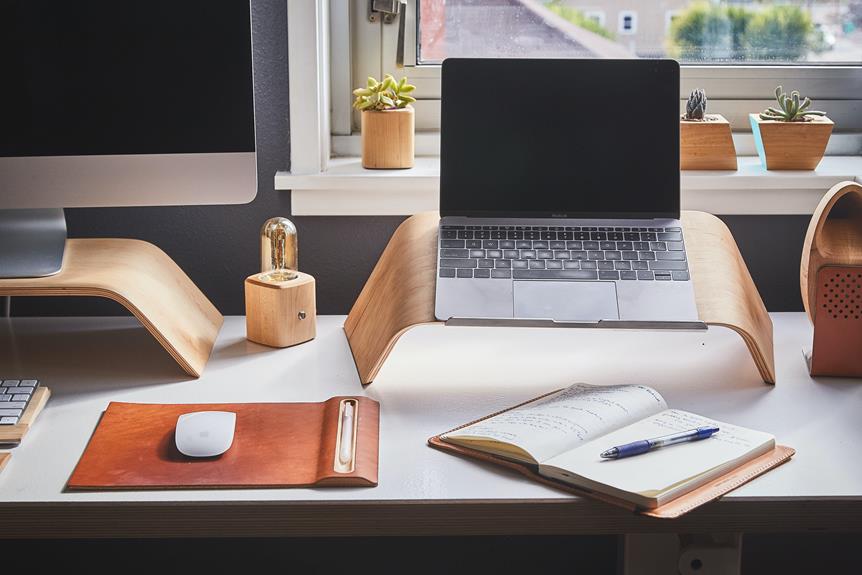Hey, home office warrior!
As you navigate the daily grind from the comfort of your own space, the question of napping might be looming like a tempting oasis in the desert of productivity. Is it a forbidden fruit or a well-deserved break?
Let's explore the uncharted territory of napping in the home office and discover whether it's a productivity killer or a secret weapon waiting to be unlocked.
So, are you ready to unlock the potential of midday snoozes and find out if it's a game-changer for your work-from-home routine?
Key Takeaways
- Napping in the home office has numerous benefits, including improved productivity, alertness, and cognitive function.
- Creating a conducive napping environment involves finding a comfortable space, minimizing distractions, and adjusting lighting and noise levels.
- Establishing a nap routine with clear goals, prioritizing tasks, and taking regular breaks can help prevent burnout and enhance overall well-being.
- Understanding employer policies and practicing napping etiquette is important, including respecting coworkers' workspace and communicating openly about nap schedules.
The Impact of Napping on Productivity
Napping can significantly improve your productivity by boosting alertness and overall cognitive function. The duration of your nap is crucial for reaping the benefits. Aim for a short nap of around 10 to 20 minutes to avoid feeling groggy upon waking.
Longer naps, between 30 to 60 minutes, can enhance memory and creativity, but may lead to some grogginess initially. Be mindful of your sleep schedule management when napping to avoid interfering with your nighttime sleep.
It's essential to create a napping environment that's conducive to relaxation. Find a quiet, dimly lit space where you can comfortably lie down. Consider using an eye mask or earplugs to block out light and noise.
Incorporating relaxation techniques such as deep breathing or gentle stretching before your nap can help you unwind and fall asleep more easily. Remember, the goal is to wake up feeling refreshed and rejuvenated.
Benefits of Napping for Mental Health
If you're looking for a simple way to boost your mental health, incorporating a short nap into your day could be a game-changer. Napping has numerous benefits for mental clarity and overall well-being. When you take a brief nap, you give your brain a chance to recharge. This can lead to improved cognitive function, better concentration, and enhanced problem-solving abilities.
Napping also helps to reduce stress and improve mood, making it a valuable tool for maintaining good mental health. One of the key benefits of napping is its ability to enhance memory and learning. When you nap, your brain processes and consolidates information, which can lead to better retention of new knowledge. Moreover, napping has been found to improve creativity and innovative thinking. By giving your mind a break, you allow it to make new connections and come up with fresh ideas.
Napping is also linked to a lower risk of developing mental health issues such as depression and anxiety. Regular napping can help regulate emotions and improve resilience to stressors. It's like hitting the reset button for your mind, allowing you to approach challenges with a clearer and more positive mindset.
Setting Boundaries for Work-Life Balance
When it comes to maintaining a healthy work-life balance, it's essential to establish clear boundaries, especially if you've been reaping the benefits of napping for your mental well-being. Setting boundaries is crucial for personal wellness, particularly in the home environment where the lines between work and personal life can easily blur.
Here are some practical tips for setting boundaries and maintaining a healthy work-life balance in your home office.
Firstly, it's important to establish specific work hours and personal time. Set a schedule for when you start and finish work each day, and stick to it as much as possible. Communicate these boundaries with your colleagues and clients, so they're aware of when you're available.
Secondly, create a designated workspace within your home. This area should be solely for work purposes, helping to mentally separate your professional and personal life. When you step into this space, it's time to focus on work, and when you step out, it's time to switch off.
Additionally, avoid the temptation to constantly check work emails or take work calls during personal time. It's important to disconnect and recharge to avoid burnout. Let your colleagues know when you're officially off the clock and won't be available for work-related matters.
Napping Best Practices for Home Offices
So, you're considering taking a nap during your work-from-home day, and you want to make sure you're doing it right. Let's talk about the benefits of napping and some strategies for incorporating naps into your home office routine.
It's important to maximize the advantages of napping while avoiding potential pitfalls, so let's get into the best practices for napping in your home office.
Napping Benefits
Napping in your home office can boost productivity and improve your overall well-being. Taking a short nap of about 10-20 minutes can enhance alertness, mood, and cognitive performance. A power nap can provide benefits such as improved memory consolidation, creativity, and problem-solving skills. However, napping for too long can lead to sleep inertia, causing grogginess and decreased performance. Creating an ideal napping environment in your home office is crucial for its effectiveness. Consider using a comfortable chair or cushion, adjusting the room temperature, and blocking out light and noise. Finding the right balance in napping duration and creating a conducive napping environment can significantly contribute to the positive effects of napping in your home office.
| Napping Duration | Benefits | Napping Environment | Effectiveness |
|---|---|---|---|
| 10-20 minutes | Enhanced alertness, mood, cognitive performance | Comfortable chair/cushion, adjusted temperature, minimal light and noise | Improved memory, creativity, problem-solving skills |
Napping Strategies
To make the most of your napping routine in your home office, consider implementing effective napping strategies that align with your productivity and well-being goals.
When it comes to napping techniques, it's essential to find what works best for you. Here are some strategies to help you optimize your napping routine:
- Power Nap: Take a short 10-20 minute nap to boost alertness and energy without feeling groggy.
- Nap Timing: Schedule your naps during the mid-afternoon slump to maximize their effectiveness.
- Sleep Schedule Management: Ensure your naps don't interfere with your nighttime sleep schedule to maintain overall sleep quality.
Navigating the Stigma Around Napping
Hey, we get it – there's this whole stigma around napping during work hours. But let's address the elephant in the room: productivity concerns.
How do you manage time effectively and still get the rest you need?
Overcoming Productivity Concerns
Navigating the stigma around napping in the home office can be challenging, but it's important to address concerns about productivity in a way that prioritizes your well-being.
Overcoming productivity concerns related to napping involves finding a balance that works for you. Here are some strategies to help you overcome these concerns:
- Time Management: Set specific time slots for napping, ensuring it doesn't interfere with important tasks.
- Energy-Boosting Rituals: Incorporate short napping techniques along with other productivity hacks like meditation or a brisk walk to maintain energy levels.
- Open Communication: Discuss the benefits of napping with colleagues or clients to create a supportive environment and reduce any stigma attached to it.
Managing Time Effectively
If you're concerned about managing time effectively while navigating the stigma around napping, it's important to establish clear boundaries and communicate openly with those around you. Here are some productivity hacks to help you make the most of your time without feeling guilty about taking a nap:
| Time Management | Productivity Hacks |
|---|---|
| Prioritize tasks | – Use the Eisenhower Matrix to prioritize tasks based on urgency and importance. |
| Set clear goals | – Set specific, achievable goals for each day to stay focused and motivated. |
| Time blocking | – Allocate specific time blocks for focused work, breaks, and even a short nap if needed. |
| Avoid multitasking | – Focus on one task at a time to improve efficiency and reduce distractions. |
Employer Policies and Napping Etiquette
When it comes to napping in the home office, it's important to understand your employer's policies and the etiquette surrounding nap breaks. Your employer may have specific considerations regarding napping during work hours, so it's essential to be aware of their stance on this issue. Here are a few key points to consider:
- Employer Policies: Check your company's employee handbook or speak with HR to understand the official policies on napping. Some companies may have designated nap areas or specific guidelines for requesting nap breaks. Understanding these policies can help you navigate the issue more effectively.
- Nap Duration: Pay attention to any guidelines related to the duration of nap breaks. Some employers may have restrictions on the length of time employees can nap during work hours. Being mindful of these guidelines can help you avoid any potential conflicts or misunderstandings.
- Etiquette: Even if napping is allowed, it's important to be considerate of your coworkers. Respect their workspace and avoid disrupting them with noise or movement when taking a nap break. Additionally, communicating openly with your colleagues about your nap schedule can help foster a more supportive and understanding work environment.
Tips for Effective Power Naps in the Home Office
After understanding your employer's policies and considering the etiquette of napping in the home office, it's important to know some tips for effective power naps that can boost your productivity and well-being.
When it comes to napping position, the best practice is to find a comfortable chair or couch that provides adequate support for your back and neck. Avoid lying down completely, as this can lead to falling into a deeper sleep and feeling groggy upon waking. Instead, consider using a reclining chair or propping yourself up with pillows to maintain a semi-upright position.
In terms of napping duration, the optimal timing for a power nap is around 10 to 20 minutes. This timeframe allows you to enter the restorative stages of sleep without descending into a deep sleep cycle, which can result in sleep inertia. It's essential to set an alarm or timer to ensure you don't oversleep and disrupt your regular sleep schedule.
Additionally, aim to schedule your power nap during the post-lunch dip, typically occurring between 1 p.m. and 3 p.m., to take advantage of your body's natural circadian rhythm.
Frequently Asked Questions
Is It Okay to Take Naps During Work Hours in a Home Office Setting?
Taking naps during work hours in a home office can be beneficial. Napping benefits include increased productivity and alertness. Don't fall for napping myths – a quick nap can actually boost your performance and well-being.
How Long Should a Nap Be in Order to Not Disrupt Productivity?
For optimal productivity, aim for a 20-minute nap. This duration can boost energy levels without leaving you groggy. Longer naps risk entering deep sleep, making it harder to wake up and potentially disrupting productivity.
What Are Some Strategies for Ensuring That Napping Doesn't Interfere With Work-Life Balance?
To ensure napping doesn't mess with work-life balance, try these strategies: set a nap duration that won't tank productivity, find a comfy spot in the home office, and schedule naps around peak energy dips.
Are There Any Specific Guidelines for Where and When It Is Appropriate to Nap in a Home Office?
When napping in the home office, consider a quiet, comfortable location to avoid disturbances. Timing is key, so nap during a lull in productivity to recharge. Respect nap etiquette to maintain a healthy work-life balance.
How Can I Address Concerns About Napping With My Employer or Coworkers?
When addressing concerns about napping with your employer or coworkers, be transparent about the benefits of short naps for productivity. Collaborate with colleagues to find quiet hours and establish clear communication with your employer.




